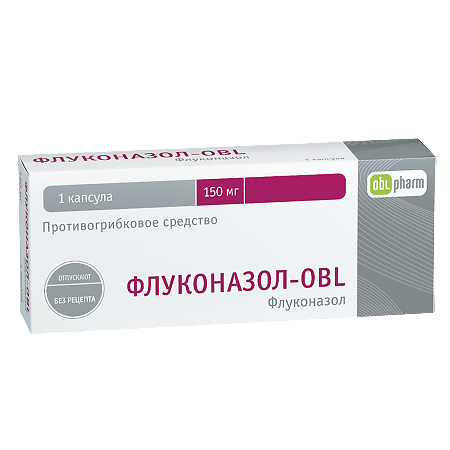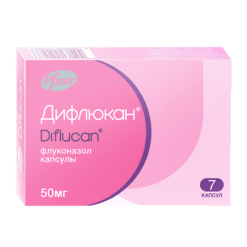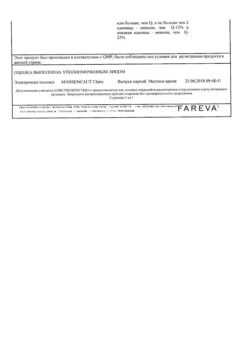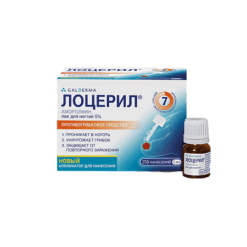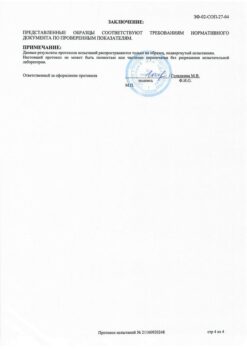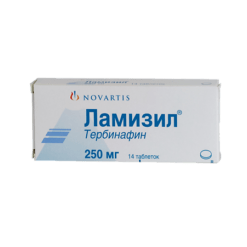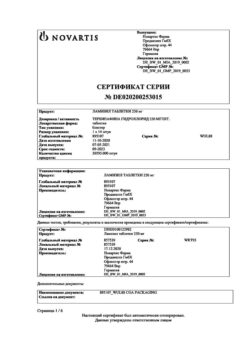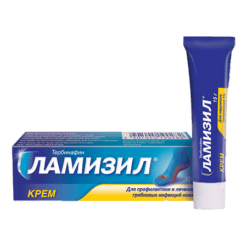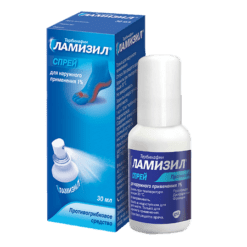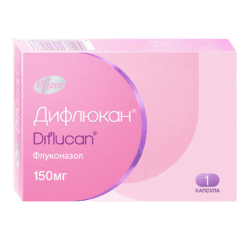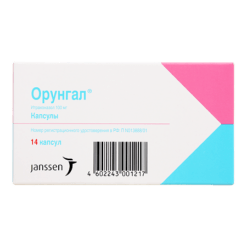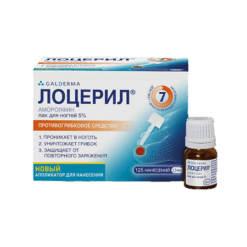No products in the cart.
Fluconazole-OBL, 150 mg capsules
€1.36 €1.24
Out of stock
(E-mail when Stock is available)
Description
Pharmacotherapeutic group:
antifungal agent
Pharmacodynamics:
Fluconazole, a member of the triazole antifungal class, is a potent selective inhibitor of the fungal enzyme 14-α-demethylase. The drug prevents conversion of lanosterol into ergosterol – the main component of cell membranes of fungi.
The drug is effective against opportunistic mycoses, including those caused by Candida spp. (Candida albicans, Candida tropicalis), Cryptococcus neoformans, Microsporum spp, Trichophyton spp. Fluconazole activity has also been shown in models of endemic mycoses, including infections caused by Blastomyces dermatitidis, Coccidioides immitis and Histoplasma capsulatum.
Pharmacokinetics:
Fluconazole is well absorbed after oral administration, its bioavailability is 90%. Maximum concentration (Cmax) after oral administration, on an empty stomach of 150 mg is 90% of plasma content when administered intravenously at a dose of 2.5 – 3.5 mg/kg. Simultaneous intake of food has no effect on absorption of the drug taken orally. Plasma concentrations reach a peak of 0.5-1.5 hours (TSmax) after administration. Plasma concentrations are in direct proportion to the dose. The 90% level of equilibrium concentration is reached by 4-5 days of treatment with the drug (when taken once daily).
The first day use of a dose twice as high as the normal daily dose allows reaching a plasma level of 90% of the equilibrium concentration by the second day. The apparent volume of distribution approaches the total volume of water in the body. Binding to plasma proteins is small – 11-12%.
Fluconazole penetrates well into all body fluids, including cerebrospinal fluid. Concentrations of the drug in saliva and sputum are similar to its levels in plasma. In patients with fungal meningitis the content of fluconazole in cerebrospinal fluid reaches 80% of its level in plasma.
In the stratum corneum, epidermis, dermis and sweat fluid high concentrations are achieved that exceed serum levels.
Less than 5% of fluconazole is metabolized on first passage through the liver. The half-life (T1/2) of fluconazole is about 30 hours. Fluconazole is mainly excreted by the kidneys; approximately 80% of the administered dose is excreted unchanged by the kidneys. Fluconazole clearance is proportional to creatinine clearance. No fluconazole metabolites were detected in peripheral blood.
Indications
Indications
– Cryptococcosis, including cryptococcal meningitis and other localizations of this infection (including lungs, skin), both in patients with normal immune response, and in patients with various forms of immunosuppression (including AIDS patients, organ transplant patients). in AIDS patients, in organ transplant patients); the drug may be used for prevention of cryptococcal infection in AIDS patients;
– generalized candidiasis, including candidemia, disseminated candidiasis and other forms of invasive candidiasis infections (infections of the peritoneum, endocardium, eyes, respiratory and urinary tract). It may be administered in patients with malignant tumors, patients of intensive therapy departments, patients undergoing cytostatic or immunosuppressive therapy and also in presence of other factors predisposing to candidiasis development;
– candidiasis of mucous membranes, including oral cavity and pharynx (including atrophic oral candidiasis associated with the wearing of dentures), esophagus, non-invasive bronchopulmonary candidiasis, candiduria, skin candidiasis; prevention of relapse of oropharyngeal candidiasis in AIDS patients;
– genital candidiasis: Vaginal candidiasis (acute and chronic recurrent), prophylactic use to reduce the recurrence of vaginal candidiasis (3 or more episodes per year); Candida balanitis;
– prevention of fungal infections in patients with malignancies who are predisposed to such infections as a result of cytostatic chemotherapy or radiotherapy;
– Mycoses of the skin, including mycoses of the feet, body, groin; pityriasis, onychomycosis; candidiasis of the skin;
– deep endemic mycoses, including coccidioidomycosis, paracoccidioidomycosis, sporotrichosis and histoplasmosis in patients with normal immunity.
Active ingredient
Active ingredient
Composition
Composition
Active ingredient:
fluconazole 50mg and 150mg.
Associates:
Corn starch,
povidone (polyvinylpyrrolidone low molecular weight),
calcium stearate.
Capsules are hard gelatin:
titanium dioxide,
proprietary blue dye,
p> gelatin,
Preservatives – methyl hydroxybenzoate,
propyl hydroxybenzoate.
How to take, the dosage
How to take, the dosage
Ingestion. The daily dose depends on the nature and severity of the fungal infection.
Adults in cryptococcal meningitis and cryptococcal infections of other localizations are usually prescribed 400 mg on the first day and then continue treatment at a dose of 200-400 mg once a day. The duration of treatment in cryptococcal infections depends on clinical efficacy confirmed by mycological testing; in cryptococcal meningitis it is usually continued for at least 6-8 weeks.
In order to prevent relapse of cryptococcal meningitis in AIDS patients, after completion of the full course of primary treatment, fluconazole is prescribed at a dose of 200 mg/day for an extended period of time. The duration of the drug is determined by the physician.
In candidemia, disseminated candidiasis, and other invasive candidiasis infections, the dose is usually 400 mg in the first day and 200 mg thereafter. In case of insufficient clinical efficacy, the drug dose may be increased to 400 mg/day; in severe systemic candidiasis, the dose may be increased to 800 mg/day. Duration of therapy depends on clinical efficacy; it should be continued for at least 2 weeks after obtaining of negative hemoculture or after disappearance of disease symptoms.
In oropharyngeal candidiasis the drug is usually prescribed 50-100 mg once daily; duration of treatment is 7-14 days. If necessary, in patients with severe immune impairment the treatment may be longer (3 weeks).
In atrophic oral candidiasis associated with the wearing of dentures, fluconazole is usually prescribed 50 mg once daily for 14 days in combination with local antiseptics for denture treatment.
In other localizations of candidiasis (except genital candidiasis), such as esophagitis, noninvasive bronchopulmonary lesions, candiduria, candidiasis of the skin and mucous membranes, etc., the effective dose is usually 50-100 mg/day with a treatment duration of 14-30 days; in severe mucosal candidiasis, 100-200 mg/day. For prevention of oropharyngeal candidiasis relapses in patients with AIDS, after completion of a full course of primary therapy, the drug may be prescribed 150 mg once a week. The duration of treatment is determined by the physician.
For vaginal candidiasis, fluconazole is taken once orally in a dose of 150 mg. To reduce the frequency of recurrence of vaginal candidiasis, the drug may be used in a dose of 150 mg once a month. The duration of therapy is determined individually; it varies from 4 to 12 months. Some patients may require more frequent use.
Fluconazole is given as a single oral dose of 150 mg for balanitis caused by Candida.
For prevention of candidiasis, the recommended dose of fluconazole is 50-400 mg once daily, depending on the risk of fungal infection. If there is a high risk of generalized infection, such as in patients with expected severe or prolonged neutropenia, the recommended dose is 400 mg once daily. Fluconazole is administered several days before the expected appearance of neutropenia; after an increase in neutrophil count above 1000/mm3, treatment is continued for an additional 7 days.
In mycoses of the skin, including mycoses of the feet, skin of the groin, and candidiasis of the skin, the recommended dose is 150 mg once weekly or 50 mg once daily. Duration of therapy in common cases is 2-4 weeks, but in case of mycoses of feet a longer therapy (up to 6 weeks) may be required.
In rubella, 300 mg once a week for 2 weeks; some patients need a third dose of 300 mg a week, while in some cases a single dose of 300-400 mg is sufficient; an alternative therapy regimen is 50 mg once a day for 2-4 weeks.
In onychomycosis, the recommended dose is 150 mg once a week. Treatment should be continued until the infected nail is replaced (the uninfected nail grows back). It normally takes 3-6 months and 6-12 months, respectively, for nails on fingers and feet to re-grow.
In deep endemic mycoses, it may be necessary to use the drug at a dose of 200-400 mg/day for up to 2 years. The duration of therapy is determined individually; it may be 11-24 months for coccidioidomycosis; 2-17 months for paracoccidioidomycosis; 1-16 months for sporotrichosis; and 3-17 months for histoplasmosis.
In children, as in similar infections in adults, the duration of treatment depends on the clinical and mycological effect. In children the drug should not be used in a daily dose that would exceed that of adults. The drug is used daily once a day.
In mucosal candidiasis, the recommended dose of fluconazole is 3 mg/kg/day. A shock dose of 6 mg/kg may be administered on the first day in order to reach steady-state equilibrium concentrations more quickly.
For the treatment of generalized candidiasis or cryptococcal infection, the recommended dose is 6-12 mg/kg/day depending on the severity of the disease.
For the prevention of fungal infections in immunocompromised children whose risk of infection is associated with neutropenia resulting from cytotoxic chemotherapy or radiation therapy, the drug is prescribed at 3-12 mg/kg/day, depending on the severity and duration of the induced neutropenia.
The maximum daily dose for children is 12 mg/kg.
Dosing for patients with renal insufficiency
Fluconazole is excreted mainly by the kidneys unchanged. There is no need to change the dose if it is taken once.
Adult patients with impaired renal function should first be given a “shock” dose of 50 mg to 400 mg when re prescribing the drug. If the creatinine clearance (CK) is more than 50 ml/min, the usual dose of the drug (100% of the recommended dose) should be used. If CK is between 11 and 50 ml/min, a dose equal to 50% of the recommended dose, or the usual dose once every 2 days, is used. For patients who are regularly on dialysis, one dose of the drug is administered after each session of hemodialysis.
In children with impaired renal function, the daily dose of the drug should be reduced (in the same proportional relationship as in adults) according to the severity of renal failure.
In elderly patients without renal impairment, the usual dosing regimen of the drug should be followed.
Interaction
Interaction
Single administration of fluconazole in the treatment of vaginal candidiasis is not associated with significant interactions. However, the following drug interactions are possible when using several or higher doses of the drug simultaneously with other medicinal products:
– Interactions of fluconazole with terfenadine, cisapride, and astemizole may result in increased plasma concentrations of these drugs, which in turn may cause prolongation of the QT interval and lead to serious cardiac rhythm disturbances. Fluconazole inhibits P450 enzymes in the liver, thus reducing the metabolism of terfenadine, cisapride and astemizole. Simultaneous administration of fluconazole and these drugs is contraindicated.
In co-administration of warfarin and fluconazole, prolongation of prothrombin time is noted. In this regard, it is necessary to monitor prothrombin time in patients receiving fluconazole and coumarin anticoagulants simultaneously.
Fluconazole prolongs T1/2 of oral hypoglycemic drugs (sulfonylurea derivatives). In patients with diabetes it is possible to simultaneously prescribe fluconazole and sulfonylurea derivatives, however, it is necessary to take into account possible risk of hypoglycemia.
– It should be taken into account that if hydrochlorothiazide and fluconazole are administered simultaneously, plasma concentrations of fluconazole are increased.
– Rifampicin accelerates the metabolism of fluconazole. The dosage of fluconazole should be increased accordingly when they are used concomitantly.
– In patients who have undergone renal transplantation, fluconazole may increase the plasma concentration of cyclosporine. In this regard, it is recommended to monitor cyclosporine concentrations in patients receiving cyclosporine and fluconazole concomitantly.
Fluconazole increases the plasma concentration of theophylline. In this regard, it is recommended to monitor theophylline concentration in patients simultaneously receiving theophylline and fluconazole.
Fluconazole may increase plasma concentrations of indinavir and midazolam. If these drugs are concomitantly prescribed with fluconazole, their dosage should be reduced accordingly.
– Clinical studies have shown that zidovudine may increase plasma concentrations when administered concomitantly with fluconazole as a result of slower metabolism. It is necessary to monitor patients receiving both of these drugs simultaneously, since in this case the frequency of side effects of zidovudine may increase.
Fluconazole increases serum concentrations of phenytoin. Doses of phenytoin should be monitored and adjusted accordingly when concomitantly administered.
– Increases the effectiveness of rifabutin (cases of uveitis have been described with concomitant use) and phenytoin to a clinically significant degree (plasma concentrations of phenytoin should be controlled when used concomitantly).
– Increases tacrolimus concentration – risk of nephrotoxicity.
Special Instructions
Special Instructions
Treatment can be initiated in the absence of culture or other laboratory test results, but if these are available, appropriate correction of the fungicidal therapy is recommended.
Because fluconazole is mainly excreted by the kidneys, caution should be exercised in patients with renal insufficiency. When treating with multiple doses of fluconazole, dosing should be adjusted for CK.
Caution should be exercised when prescribing fluconazole to patients with impaired liver function. Liver enzyme levels should be monitored regularly during treatment and patients should be monitored for possible toxic effects. If the level of liver enzymes increases, the physician should weigh the benefit of the therapy against the risk of severe liver damage. Hepatotoxic effects of fluconazole are usually reversible; symptoms disappear after discontinuation of therapy.
AIDS patients are more prone to develop severe skin reactions when using many drugs. In cases where patients with superficial fungal infection develop a rash and it is considered definitely related to fluconazole, the drug should be discontinued. If a rash develops in patients with invasive/systemic fungal infections, they should be closely monitored and fluconazole should be discontinued if bullous changes or erythema multiforme appear.
Protrombin time should be monitored in patients receiving fluconazole and coumarin anticoagulants simultaneously.
The treatment should be continued until clinical and hematological remission occurs. Premature discontinuation of treatment leads to relapses.
The proprietary blue dye in the drug can cause an allergic reaction.
Impact on the ability to drive or operate a motor vehicle or other mechanical devices: No known adverse effect on the ability to drive or operate other mechanisms.
Contraindications
Contraindications
Hypersensitivity to fluconazole, other drug components or other azole compounds; concomitant use of terfenadine (with continuous use of fluconazole at a dose of 400 mg/day or more), cisapride or astemizole and other drugs prolonging the QT interval and increasing the risk of severe rhythm disturbances; lactation; children under 3 years (for this dosage form).
With caution: hepatic and/or renal insufficiency, occurrence of rash on fluconazole in patients with superficial fungal infection and invasive/systemic fungal infections, simultaneous administration of terfenadine and fluconazole at a dose less than 400 mg/day, potentially proarrhythmogenic conditions in patients with multiple risk factors (organic heart disease, electrolyte balance disorders, simultaneous administration of drugs that cause arrhythmias); patients with intolerance to acetylsalicylic acid, pregnancy.
Side effects
Side effects
Digestive system disorders: nausea, diarrhea, flatulence, vomiting, abdominal pain, change in taste, rarely – increased activity of “liver” enzymes and liver function disorders (jaundice, hyperbilirubinemia, increased activity of alanine aminotransferase (ALT), asparagine aminotransferase (AST) and alkaline phosphatase (ALP), hepatitis, hepatocellular necrosis), including.including fatal.
Nervous system disorders:headache, dizziness; rarely – seizures.
Hematopoietic organs: rarely – agranulocytosis, neutropenia. In patients with severe fungal infections hematological changes (leukopenia and thrombocytopenia) may be noted.
Cardiovascular system disorders:increased Q – T interval duration on electrocardiogram (ECG), ventricular fibrillation/tremble.
Allergic reactions:skin rash, erythema multiforme (including Stevens-Johnson syndrome), toxic epidermal necrolysis (Lyell’s syndrome), bronchial asthma (more often with intolerance to acetylsalicylic acid), anaphylactoid reactions (including angioedema, facial edema, urticaria, skin itching).
Others: rarely – renal dysfunction, alopecia, hypercholesterolemia, hypertriglyceridemia, hypokalemia.
Overdose
Overdose
Symptoms: nausea, vomiting, diarrhea, in severe cases seizures, hallucinations, paranoid behavior may be noted.
Treatment: symptomatic, gastric lavage; since fluconazole is excreted by the kidneys, forced diuresis is recommended. Hemodialysis within 3 hours reduces concentration in plasma by 2 times.
Similarities
Similarities
Additional information
| Weight | 0.010 kg |
|---|---|
| Shelf life | 2 years. |
| Conditions of storage | In a dry, light-protected place at 15-25 °C. |
| Manufacturer | Alium JSC, Russia |
| Medication form | capsules |
| Brand | Alium JSC |
Related products
Buy Fluconazole-OBL, 150 mg capsules with delivery to USA, UK, Europe and over 120 other countries.

